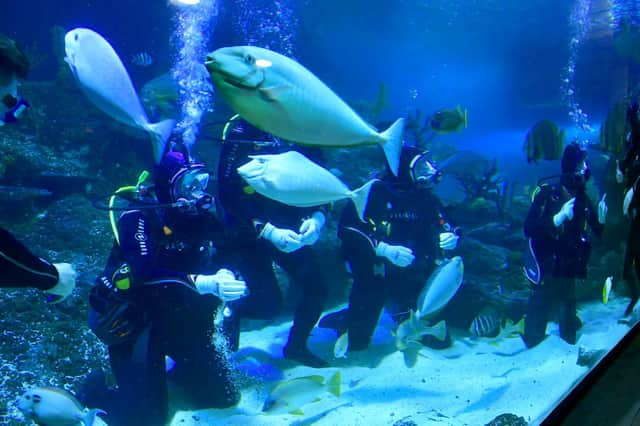In fact, the longest resident in the tropical depths of the aquarium's coral ocean display is far from the great white killer made famous in the 1975 movie 'Jaws'.
He is interested in divers for one reason only - to tickle his tummy with their air bubbles.
Skegness Aquarium has been promoting its Dive and Snorkeling Centre since the attraction opened in 2015 - but the latest package on offer is exciting the dive team more than ever.
An upgrade in the equipment used means they are now able to offer the full experience to families who have never scuba dived before or even tried snorkeling.
Dive Team officer. Jamie Elvidge explains: "We've invested in full face masks which means divers can breath normally and it allows people who have never dived before the opportunity to have a go."
I decided to test out the claim and joined other relatively inexperienced divers to meet the aquarium's sharks, rays and other sea life creatures.
At this point it might be worth mentioning that my closest attempt to snorkeling was on holiday with turtles but I never managed to master the mouthpiece and the whole experience ended up a spluttering mess.
A full face mask definitely seemed the answer for me. However, it didn't mean there was no preparation.
Skegness Aquarium runs its dives in association with the Sharks Trust and the British Sub-Aqua Club (BSAC), which means the experience starts as soon as you receive your confirmation email.
There are three modules to wade through which fully prepare you to get the most out of your dive and, more importantly, keep you safe and prevent harm to the tanks occupants.
There's no flipping through this stage and relying on the pre-dive briefing - there is a test to take and you have to achieve 4/5 to pass even before you get near water.
Once you have completed the eLearning there are more stages to go through in preparation. Showering is important to protect the fish and then it's time to put on your wetsuit and swim shoes. There is also a hood to protect your hair because the fish love to nibble at it and, finally, gloves.
Nudge is never far away while all this is going on and as we gathered by the 2m platform where we would be descending for the first stage of the experience, I spotted him circling.
There is no reason to worry, though. Tiger sharks eat crabs and crustaceans and all the tropical fish are fed before each dive by the zoo team, who also keep a close eye on the water quality.
We are seated for the equipment we need to complete the dive is fitted. This includes a weight jacket as well as an air tank and the full face mask.
Having completed the briefing with dive team's Josh Brown and Adon Harrison, one by one we descend a metal ladder into the 2m platform of the coral display, experiencing being under water for the first time.
Descending the ladder was covered in one of the training modules and, in the briefing, we were again instructed to hold onto the handrails to prevent us being pulled backwards into to water.
My first challenge was actually getting off the bench - with 30kg on my back, even when the air tank was unclipped from the wall I wasn't going anywhere without the assistance of our photographer David Dawson, who by this time finding the whole process amusing.
Once up on my feet it was a slow walk to the ladder and and I held onto the handrail for my life.
Dive instructor Adon Harrison was at the bottom of the ladder to reassure me for the moment I went under water for the first time.
Kneeling behind bolders that had been placed for the divers to hold on to, we went through some equalisation practice and air checks to ensure we were confident with the equipment before descending to the 4m level.
The 2m platform is also a safe environment where divers can get used to moving along with knees bent, leaning forward and hands together in front of us. Swimming motions are discouraged, as are reaching out to touch the fish. Their safety is always paramount.
'Granny shark' Pauline Chiverton-Simpson has been a member of the team since the aquarium opened and, at aged 74, she loves it as much as ever.
Pauline started diving on holiday at 55 and was a member of a local scuba diving club that went along to help get the aquarium ready to open.
She's been there ever since and said: "One of the best things is when you get someone who is scared and clinging on to you and gradually with our encouragement they get braver and they are away.
"It's what I love about being part of the team."
Slowly we moved along and were encouraged to kneel while the dive instructors scattered food around us to encourage the fish to come closer.
By now we start to forget about the weight on our backs and settle down to enjoy the most amazing part of the dive - the experience of breathing underwater surrounded by the most beautiful tropical fish.
Suddenly we see our friends and relations from the other side of the glass, who seem equally amazed and overjoyed to see us there.
We move along to a corner where, once again, we kneel and are encouraged to grab handfuls of sand and let it float back down.
"The fish love this," Jamie explained afterwards. "They use the falling sand as a way to itch parasites. We call it a simulation of a natural cleaning station. Like exfoliation."
A bat fish, one of the biggest in the aquarium, seemed to like my technique and kept coming back for more. That was the moment - the special interaction with nature you feel privileged to be part of.
All too soon the experience which lasted around an hour was over. It would be fair to say that at some some stage all of the session's divers had been excited, nervous or even scared.
But the professionalism of the dive team the training given beforehand and during meant that, even for the least experienced person, someone was with you all the way.
After showering, I caught up with some of the others experiencing the dive.
Katie Cope, 43, from Derbyshire had been staying at Tattershall Lakes and had come over to Skegness especially. "It was the Christmas present from my brother that I never realised I wanted," she said. "I had tried scuba diving 30 years ago but this was great - the dive team were really helpful and took us through everything. And the interaction with the fish was special. They really seemed to enjoy it."
Dad and daughter - Craig Lee and Melissa Setherton, 12 - were also buzzing. They were on holiday from Devon and were surprised how good it was.
"It was awesome," said Craig. "A massive sucker-like fish came and sat on my toe. We can't wait to explore the rest of the aquarium now."
Melissa had done wild water swimmer before but this was something new. "I really enjoyed interacting with the fish. I'd do it again."
For Lee Beardall of Sheffield the experience had been a Christmas presnt. "I've been scuba diving on holiday and wanted to try this.
"I really enjoyed it and it's certainly something I want to do again on holiday."
The dive team now hope more people will have a go. "This experience was already an amazing one, but with the use of cutting edge mask technology combined with underwater diver communications, our breathtaking experience really has been enhanced," said Jamie.
"The masks allow for more comfort, ease of breathing and verbal reassurance by the instructor - all whilst boosting safety as the masks cannot become dislodged.".
Dives in the Coral Ocean Display inhabitants are offered food three times a day, in-between dives at 11am, 1pm and 3pm for ages 10 upwards.
Other experiences include Shark Snorkelling Experience for 6-11 year olds; Shark Educational Dive for aged 10 upwards and Bespoke Sub Aqua Packages.
For more details visit https://dive.skegness-aquarium.uk.
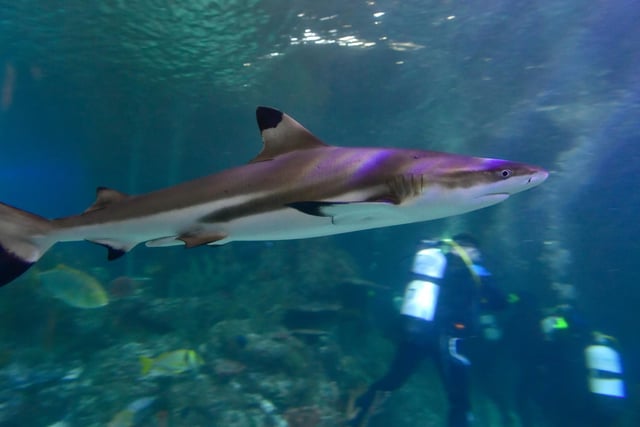
1. SKEGNESS AQUARIUM
He's behind you - one of Skegness aquarium's five sharks keeping an eye on the divers. Photo: JPI Media
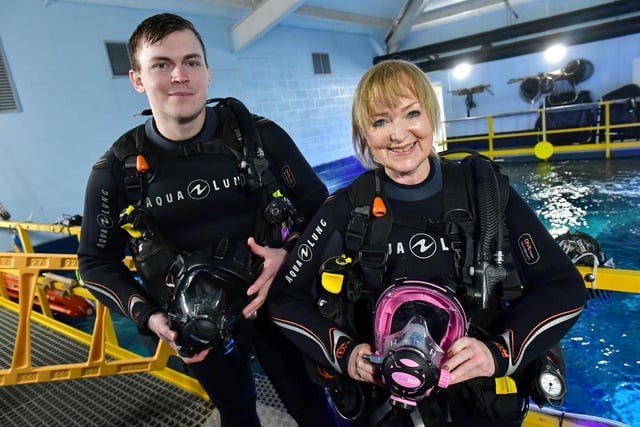
2. SKEGNESS AQUARIUM
Reporter Chrisie Redford prepares to dive for the first time, assistad by dive instructor John Brown. Photo: JPI Media
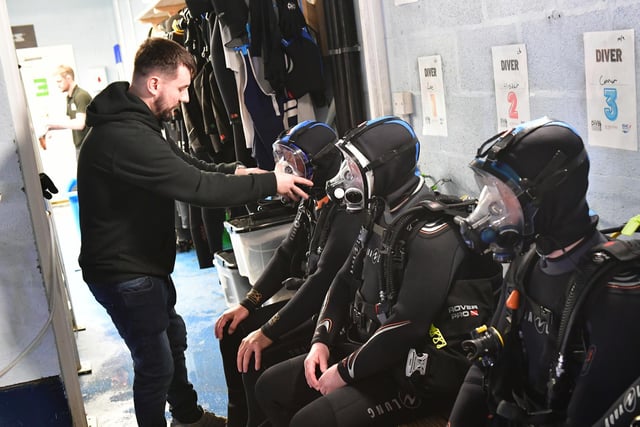
3.
Divers remain seated while instructor Adon Harrison fits the equipment. Photo: JPI Media
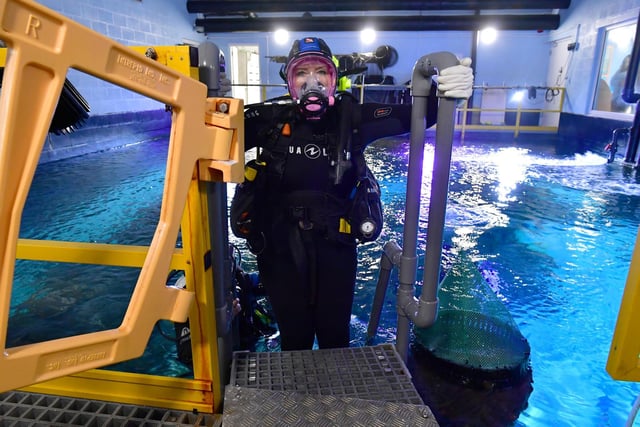
4. SKEGNESS AQUARIUM
Going down - reporter Chrissie Redford clinging to the rails with 30kg of equipment on her pack. Photo: JPI Media
